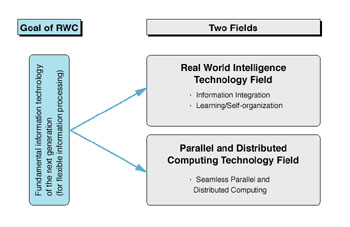
Fig 1-1 Research and Development in RWCP Project
The RWC Project will end in the next fiscal year as stated in the initial plan (March, 2002).
Thus, in the final year before the Project ends, the Real World Computing Partnership has compiled a final summary of the completed results of research and development from laboratories at Tsukuba Research Center and Distributed Laboratories, and submitted it as an interim report to the promotion committee for Fundamental Information Technology of the Next Generation under the Ministry of International Trade and Industry (MITI), as well as the general affairs committee meeting and the research committee meeting.
The feedback on this interim report will be reflected on the research and development in this and the next fiscal years and the Projects research results will be presented at RWC Final Exhibition and Symposia 2001 (RWC 2001).
I. Outline
1. Summary
In this project, new paradigms - seamless parallel and distributed computing in the parallel and distributed computing field, and information integration technology in the real world intelligence field - were proposed and demonstration systems have been developed.
The project anticipates the proliferation of computer networks and advances in semiconductor and optical technologies, which will constitute a new trend in information technologies in the future (Fig. 1-1).

Fig 1-1 Research and Development in RWCP Project
Most of the technical developments so far may be classified as stage (2) and (3) below, and therefore the Projects initial goal of establishing key technologies is expected to be accomplished:
(1) Basic technologies under development
(2) Basic technologies
established, and being tested or prototyped in the laboratory
(3)
Prototyping completed, fields for application and users being sought
(4)
Intermediate results already in use
It should be noted that some of the results are already highly valued both in Japan and overseas, and intermediate results are even being utilized while the Project is underway (those in (4)). In this sense, the initial goals of the Project have been exceeded.
2. Information Integration
Information processing technologies for
handling speech, motion images, and documents have been studied separately by
several research institutes, while the Project has studied new information
technologies to handle these multimodal types of information in an integrated
manner, picking up many research themes and demonstrating their effectiveness
for the first time in the world.
Specifically, they include development of CrossMediator, which enables us to handle speech, motion and still images, and documents as raw data and also search for them in an inter-related manner; development of the Jijo-2 robot as an autonomous learning system; development of a multimodal interactive system involving gesture and face recognition; and development of sign language recognition.
3. Seamless Parallel and Distributed Computing
A seamless parallel
and distributed computing system is a system that enables us to use many
computers linked in a LAN environment as a single computer.
This technology allows the construction of super-computers consisting of PCs and a high-speed optical network, as well as high-performance network servers such as data mining servers for storing large amounts of information. Because the technology runs heterogeneous computers, it allows old and new models to be mixed, and also cooperation among heterogeneous computers such as vector and scalar computers. It will thus provide a basis for constructing and applying high-performance, high-reliability, yet cost-effective servers, which will become increasingly important in the networked society of the future.
The core software for the system, i.e., global OS (SCore) and compiler (Omni OpenMP), is available as freeware, which will promote its popularity and create a new genre of freeware business. In addition, a parallel application program called PAPIA (parallel protein information analysis system) was developed, different simulation technologies were united, and application technologies such as data mining were developed.
In the field of optical interconnection, which is particularly important in parallel and distributed computing, a large volume optical switching interface system was developed, which operates at the highest transmission speed in the world. Regarding optical interconnection technology offering transmission speeds in excess of 100 Gbps, surface emitting devices were prototyped successfully which enable high-density parallel transfer of information.
4. Practical use/Commercialization of products
Most of the
research results from our laboratories are expected to be implemented as
stand-alone products or integrated into other systems within several years (see
Table 1 and Fig. 1-2).
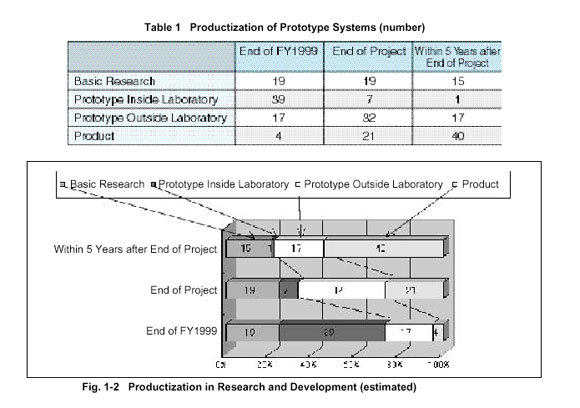
Those already in practical use include:
(1) In Real World Intelligence,
CrossMediator, which is already implemented as a product, and dynamic adaptive
device technology, which is used in commercial LSI systems.
(2) In Seamless
Parallel and Distributed Computing, SCore Software System (global parallel OS),
which is used for simulations worldwide, OmniOpenMP compiler, which is
downloaded and used by many sites, and PAPIA, which is used widely around the
globe via WWW.
[Objectives of Research and Development]
Current information
technologies build on logical and procedural information processing, suitable
for those applications that process information effectively according to
pre-determined algorithms, but insufficient in many aspects when dealing with
real world information characterized by immense diversity and ambiguity.
To deal with this, the objective is to develop fundamental technologies to add information integration and learning-type information processing (real world intelligence) to the conventional information processing technologies, and thus to be able to accept raw real world information, recognize or predict the environment and situation, and autonomously respond to it.
Specifically, 1) Multimodal Functions (agent-driven human interfaces to use information systems in natural interactions combined with speech and images), 2) Autonomous Learning Functions (agent systems which can autonomously move around in the real environment, gather information and learn about their environment and surroundings via sensing and interactions for deciding their actions), and 3) Self-Organizing Information Base Functions (agent systems which can consolidate, summarize, retrieve, and present various information in a self-organized manner in the real world or on an information network) are being researched and developed for demonstration systems, and in collaboration with 4) Research on the Theoretical and Algorithmic Foundation, the foundation for information integration, learning/self-organization technology, and so forth should be established. In addition, 5) Real-time and Adaptive Devices are also being developed to help realize these technologies.
[Current Status of Research and Development]
Many themes are now
at the stage of looking for applied fields and/or users, after going through the
evaluation stage via prototyping and experiments within laboratories, or are at
the prototyping stage. Real world intelligence technologies are frequently
demonstrated with actual machines in the real environment of demonstration sites
where many people gather, as well as inside laboratories. In addition, the
intermediate results of some themes are at the implementation stage, such as
Multimodal Interface, CrossMediator, reconfigurable adaptive devices, and
artificial reality with FTA (see Fig. 2-1).

Fig. 2-1 Research and Development in Real World Intelligence Technology Field
1. Multi-Modal Functions
1.1 Objectives
To research and develop the next-generation human
interface between the information world and humans to enable computers to be
used in natural interactions combining speech and images.
1.2 Significance
The current interfaces between computers and
humans are mainly the keyboard and mouse. However, to deal with increasing
numbers of users and applications in the future, a multimodal interface should
be developed via speech, images, motion of hands and gestures, and even facial
expressions to convey the feelings that humans usually use. This will cultivate
new application fields, while making computers much easier to use and increasing
the number of users.
1.3 Approach
Speech/Gesture Recognition System 2. Autonomous Learning Functions
2.1 Objectives 2.2 Significance 2.3 Approach As an integrated system, the Jijo-2 Robot will be developed which provides
services such as office guidance, searches for people, and schedule
coordination.
Office Robot "Jijo-2" 3. Self-organizing Information Base Functions
3.1 Objectives 3.2 Significance
As digital archives of such multimodal data grow drastically, automatically
organizing high volumes of diverse information and implementing inter-retrieval
functions will enable users to efficiently access the information they need. The
methods, targets, and functions for retrieval can thus be extensively improved
over the conventional keyword-only retrieval or text-oriented retrieval with
relational databases.
3.3 Approach 4. Theory and Algorithm Foundation
4.1 Objectives 4.2 Significance 4.3 Approach 5. Real World Adaptive Devices
5.1 Objectives
5.2 Significance
In this area, next-generation FPGA (Field Programmable Gate Array), which is
reconfigurable at the hardware level to suit each application algorithm with the
optimal structure and thus help realize high-speed processing, and a parallel
optical processing system to achieve super-high-speed image processing, will be
developed to enable fast and flexible real-time processing of various real world
information.
5.3 Approach (2) Parallel Optical Processing System III. Parallel and Distributed Computing Technology Field
[Objectives of Research and Development] Hence, the objectives are to develop fundamental technologies required for
realizing a next-generation parallel and distributed processing environment
(seamless parallel and distributed computing environment) which dynamically
reconfigures heterogeneous computing resources existing on distributed systems
to provide optimal parallel processing capability and to develop elementary
parallelization techniques, which are important for realizing high-speed
processing on multiprocessor systems, in order to address the demand for
flexibly changing computer processing.
In addition, parallel applications will also be developed for demonstration
which run effectively in a parallel environment.
[Current Status of Research and Development] For optical interconnections under a communication mechanism, a network
system interconnecting computers operating at 8 Gbps per port, the fastest in
the world, and a technology to support 100 Gbps in the future, are being
developed. Eventually, a demonstration system for seamless parallel and
distributed computing will be constructed to integrate the following basic key
technologies:
In the field of parallel applications, the parallel protein information
analysis (PAPIA) system and high-speed Molecular Dynamics Simulation system,
running on the SCore Cluster System, are being developed.
Note that multi-processor computing, in which remarkable results were
accomplished by FY1999 as described later, will form a separate project in
FY2000 for more detailed work (see Fig. 3-1).
1. Seamless Parallel and Distributed Computing
1.1 Objectives 1.2 Significance Currently, high-speed computing servers and large-scale database servers link
within a single enclosure or multiple adjacent enclosures over dedicated
networks. These are expensive and power-consuming. In addition, they require
special computer rooms to accommodate them with high-capacity power and
air-conditioning facilities, and they usually are the same model using the same
operating system. On the contrary, our new paradigm makes it possible to use a
variety of networked PCs and/or workstations as a single computer, for building
super-computers and various servers at low cost with lower energy consumption.
[Optical Interconnections] 1.3 Approach (2) Development of parallel language compiler (3) Development of seamless parallel OS
[Optical Interconnections] (5) Development of elementary technologies for super-high-speed optical
transmission in the future
2. Parallel Applications
2.1 Objectives 2.2 Significance In addition, as systems become more complicated, the cost of developing
application programs will be a bottleneck to parallel applications. By
developing technologies to fuse existing simulation programs, analyses of
complicated systems will be made easier.
2.3 Approach (2) To integrate different simulation models, techniques to integrate
existing simulation software and fuse micro- and macro-level simulations will be
developed.
3. Multi-processor Computing
3.1 Objectives 3.2 Significance
The research and development in this area had accomplished the key results by
FY1999, potentially revolutionizing the effective performance of computers.
Because of its importance, it was decided that this area would be a separate
project from FY2000.
3.3 Approach

Information Providing
Terminal under Trial Use in Isahaya City
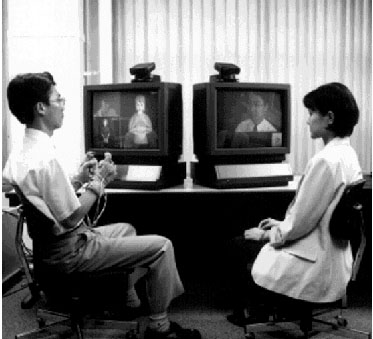
Sign Language Recognition
System
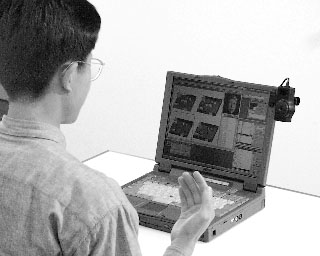
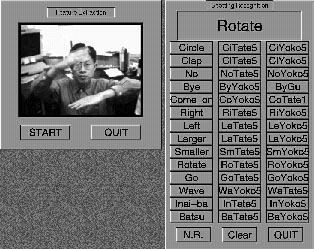
To develop technologies for autonomously moving
around an office to gather real world information and present it to humans, and
to develop a system that integrates the technologies.
Since computers will have the ability of actively
and automatically understanding various information in the real world (speech,
surrounding sound, movements of people, etc.), humans will not have to enter
information. In addition, using real world information they understand, machines
can coexist with humans through natural communications.
For an office environment, research will be conducted
on sensing and representation of the real world, integrated learning from
multiple information sources, and autonomous information gathering and learning.
Specific developments include visual sense for tracking people, recognition of
surrounding sound, speech conversation, and navigation method.
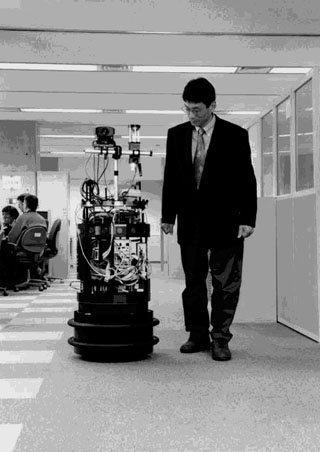
To develop technologies for automatic organization
and inter-retrieval of high volume multimodal data such as speech, images (both
still and motion), text, and so forth.
As networks advance, ever-larger information
databases are being built. In addition, the forms of media used for information
are shifting from conventional text-oriented to a variety of media such as
motion images and speech.
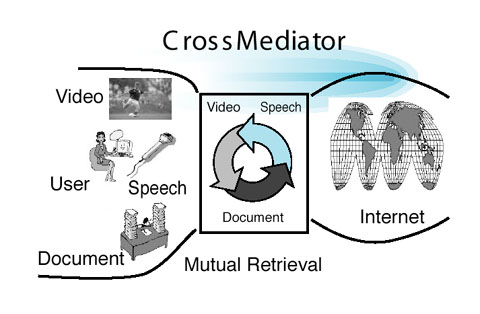
Conceptual Diagram
of CrossMediator
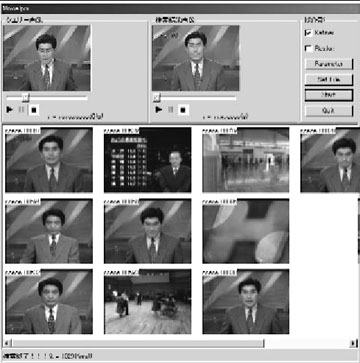
Example of Motion Image Retrieval
of CrossMediator
Technologies for segmentation, self-organization, and
unification of different information for multimodal data will be developed.
Specific research approaches are:
To develop a theoretical foundation and basic
algorithms for learning and integrated information processing in the real world.
In this area, it is expected that various real
world intelligence systems will be developed by establishing a common foundation
for them using the following results:
(1) Academic contribution to key
technologies for real world intelligence with papers
(2) Creation of
software and libraries
(3) Demonstrations for evaluation by applying them to
real world problems
(4) Demonstrations by applying them to real world
intelligence prototype systems
Research will be conducted in the following areas,
using probabilistic and statistical methods as a common foundation:
(1) Base
knowledge and representation of probability distribution models with a dynamic
structure
(2) Maximum use of multimodality, familiarity with humans, and
parallel and distributed nature of real world intelligence
(3) Elemental and
demonstration research will be conducted in parallel and integrated
To develop technologies for electronic adaptive
devices (next-generation FPGA) and optical adaptive devices (digital smart
pixels) to realize efficient real world information processing.

Example of Using
Probabilistic Knowledge Discovery Tool BAYONET
To establish real world intelligence
technologies, it is necessary to quickly process large volumes of real world
information such as speech and images in real time. Processing using
computer-based software is very flexible but slow. On the contrary, by creating
hardware specific to each application algorithm, processing is fast but the
development and manufacturing are expensive, and flexibility is poor.
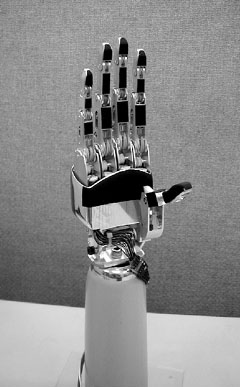
Myoelectric Prosthetic Hand
(1) Next-generation FPGA
Methods will be studied
for configuring static adaptive devices applicable to processes with fixed
algorithms and dynamic adaptive devices for algorithms which change in time or
depending on data.
By developing an optical input, OE
converter, parallel operation, EO converter, and optical output sections in an
array configuration, a parallel optical processing system will be developed
which can be cascaded.
The increase in speed of
device technologies is expected to approach the physical limit at the beginning
of the 21st century, and hence parallel and distributed technologies at various
levels will be the key to improving the performance of computer systems.
In the field of
seamless parallel and distributed computing, key technologies such as
communication mechanisms, a global operating system, parallel languages, and so
forth have been developed and will soon be completed.
SCore Cluster System Software
To realize a seamless parallel and distributed
computing environment that can dynamically configure computing resources
connected via a network according to different demands, and that allows us to
use them as a single computer. Also, to develop optical interconnection
technology for high-volume high-speed data transfer.
[Seamless Parallel and Distributed
Computing]
The seamless parallel and distributed computing in this
Project proposes a new computing paradigm in that users, without being aware of
the distributed environment, can exploit the computing power they need from
distributed computers across a network as a single computer.
One bottleneck in parallel computing is
inter-processor speed. The main method at present is to use specialized switches
to wire those processors, but this involves problems of transmission speed and
distance. These will be solved by the high volume transmission capacity of
optical interconnections, which enable fast inter-processor linking with lower
power consumption.
[Seamless Parallel and Distributed Computing]
(1) Development of high-speed communications networks
A new high-speed
communication mechanism will be developed to solve the problem of communication
delay and speed, which constitute a bottleneck to parallel computing over a
network.
An easy-to-use
general-purpose compiler and library will be developed for standard languages.
A global OS and library will be
developed to provide a seamless OS which enables users to use networked
computers as a single computer.

RHiNET Switch System
(4) Development of high-speed optical
information exchange system
Interconnection using switches and optical
fibers will be developed to realize high-speed high-volume optical information
communications.
Fundamental technologies for near-future optical
interconnections exceeding 100 Gbps will be developed.

Conceptual Diagram of LASN

SCore Cluster System
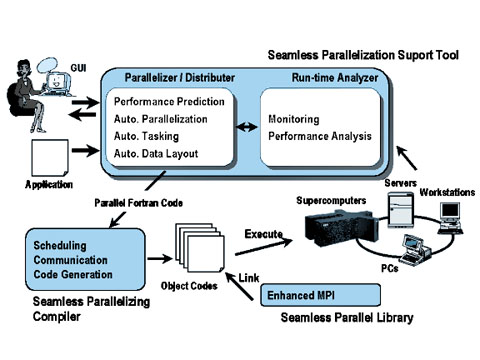
Development and User Environment on
Heterogeneous Parallel Distributed System

Optical Switch System for RHiNET
To develop leading-edge parallel application
technologies and study simulations in parallel applications, mainly for
chemistry, biology, and large-scale systems, where parallel computers are
expected to be exploited widely.
Parallel computing is expected to be exploited in
every field of science and technology. Computing techniques have already been
established for structure analysis and fluid dynamics simulations. In this area,
parallel application technologies will be developed for the new applications of
the future. Especially, computational biology is attracting attention as a key
theme in the 21st century, and parallel applications for genome databases are
likely to play a key role in the advances in this field. Also, data mining to
retrieve data from large information repositories is a likely application for
parallel computing. This research will enhance the applicability of seamless
parallel computing by developing parallel application technologies for these
fields.
(1) Parallel application technologies will be
developed mainly for life sciences (computational biology), computational
chemistry, and large-scale systems (i.e., power flow computation, data mining)
where parallel application will play an important role.
To develop elementary technologies for parallel
compilers and scheduling which will be key technologies for parallel computing.
While the maximum theoretical performance of
parallel computer hardware dramatically increases year after year, the effective
performance of parallel operations is below 50% of the maximum theoretical
performance, and the discrepancy between the maximum theoretical performance and
the effective performance is widening. By developing elementary parallelization
techniques as key technologies, specifically a technique to extract parallelism,
scheduling to efficiently map parallelism onto hardware, and support systems,
the effective performance of multiprocessor systems will be improved.

PAPIA System

PAPIA's WEB Site
Basic technologies, i.e., to extract parallelism,
will be developed by analyzing sequential programs at both micro and macro
levels.